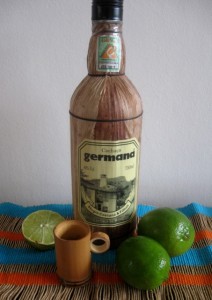
Photo © Michael Sommers.
Yesterday was one of those quintessential Saturdays in Salvador. At around 11am, my friend Edivaldo called me and recommend that I come for lunch since he was in the mood to cook. When I asked what time I should arrive, he answered around 12pm – so I showed up around 1pm. Pots and pans were cluttered all over the kitchen and appetizing smells were coming from the vicinity of the stove. My friend Myra, Edi’s wife, came in and gave me a kiss hello/goodbye as she left for a big lunch somewhere else. “I won’t be gone long,” warned Myra. “Stick around and we can go out for drinks tonight.” It became apparent that Edi’s big banquet would just be for him and me.
While waiting for things to stew (feijão verde, or beans), boil (potatoes), roast (lamb soaked in cachaça), and toast (the (farofa, or toasted manioc flour), Edi and I sat in the kitchen and abrimos o apetite (“opened our appetites”) with a few shots of silky smooth cachaça brought by a friend who lives in Minas Gerais (a state renowned for its fine cachaças). After lunch – (which we ate at around 4pm, but only because I subtly hinted that I was getting hungry) – both Edi and I were worn out by our efforts. So we lay down on the cool kitchen floor and sipped some more cachaça… until Myra came home at 8pm. Soon after, we headed out, bound for Salvador’s lively bohemian bairro of Rio Vermelho – to drink cachaça!
For those unfamiliar with cachaça, it’s Brazil’s equivalent of Cuba’s rum, Mexico’s tequila, and Russia’s vodka.The thing is that Myra doesn’t like beer and she had discovered a new cachaçaria that had recently opened. As you might very well imagine, a cachaçaria is a bar that specializes in cachaça. The one that we went to is called Água Doce (Sweet Water – “água” being a popular euphemism for any hard liquor, but specifically cachaça) and it claims fame to the somewhat droll, but not inconsequential title of biggest cachaçaria chain on the planet.
For those unfamiliar with cachaça, it’s Brazil’s equivalent of Cuba’s rum, Mexico’s tequila, and Russia’s vodka. Distilled from fermented sugar cane juice, it packs a wallop with an alcohol content that hovers between 38 and 48 percent. Brazilians either drink cachaça pure or mixed with sugar, crushed ice and lime, at which point it morphs into the world-famous and highly addictive national cocktail known as the caipirinha.
“Caipis” and other cocktails are usually made with the clear, industrially manufactured varieties of cachaça – such as Pitú and 51 – that one can find in any supermarket or corner store. Dirt-cheap, these are pretty harsh tasting on their own. If you want to savor cachaças on par with the world’s finer aged whiskies, you’re better off choosing from one of the many artisanal varieties produced at small mills throughout the country and sold directly to bars, restaurants and gourmet delicatessens. Their myriad fragrances and flavors often depend upon the barrels in which they’re aged; many are made from native trees such as almond, brazil wood, and exotically named ipê and jequitibá.
Cachaça has been around since Brazil’s earliest days as a colony. It began life as a drink imbibed by African slaves who worked on sugarcane plantations; subsequently, and until quite recently, it was looked down upon as a poor man’s poison. However, over the past decade, the fabrication of artisanal and even organic cachaças has led to a major boost in the sprit’s rep, with aficionados savoring it as if it were a top notch single malt scotch.
Recently, the Brazilian government and producer associations succeeded in trademarking the cachaça name with the goal of marketing it – at home and abroad – as a fine alcohol. In fact, if you happen to be in São Paulo next week, consider checking out the 7th Annual Brasil Cachaça Fair (April 27-29), which will bring together over 400 cachaça makers (out of an estimated 40,000) from all over the country who will be offering samples of their premium “pingas” (slang for cachaça – a pinga is a drop).
Otherwise, if you’re in Salvador – or São Paulo, Brasília, Curitiba, Maceió, Porto Alegre, Cuiabá, Foz de Iguaçu, or any of the 100 cities and towns throughout the country that have an Água Doce of their own (the one exception being Rio de Janeiro– in which case, I recommend the Academia da Cachaça, in Leblon) – drop into this (cachaçaria and do some sampling of your own (check the website for locations – if you’re in São Paulo state, home of the original outlet, keep in mind that many branches offer delivery!).
Choose from over 200 cachaças ranked according to origin, quality, age, and price (an accompanying menu of hearty, typical Brazilian dishes will help prevent the alcohol from going to your head). Although Água Doce also offers a variety of rather flamboyant looking cachaça-based cocktails, I highly recommend indulging in at least one shot of the pure stuff – you never know: if you happen upon the right bottle, you may even be inclined to replace your scotch habit with a cachaça habit.